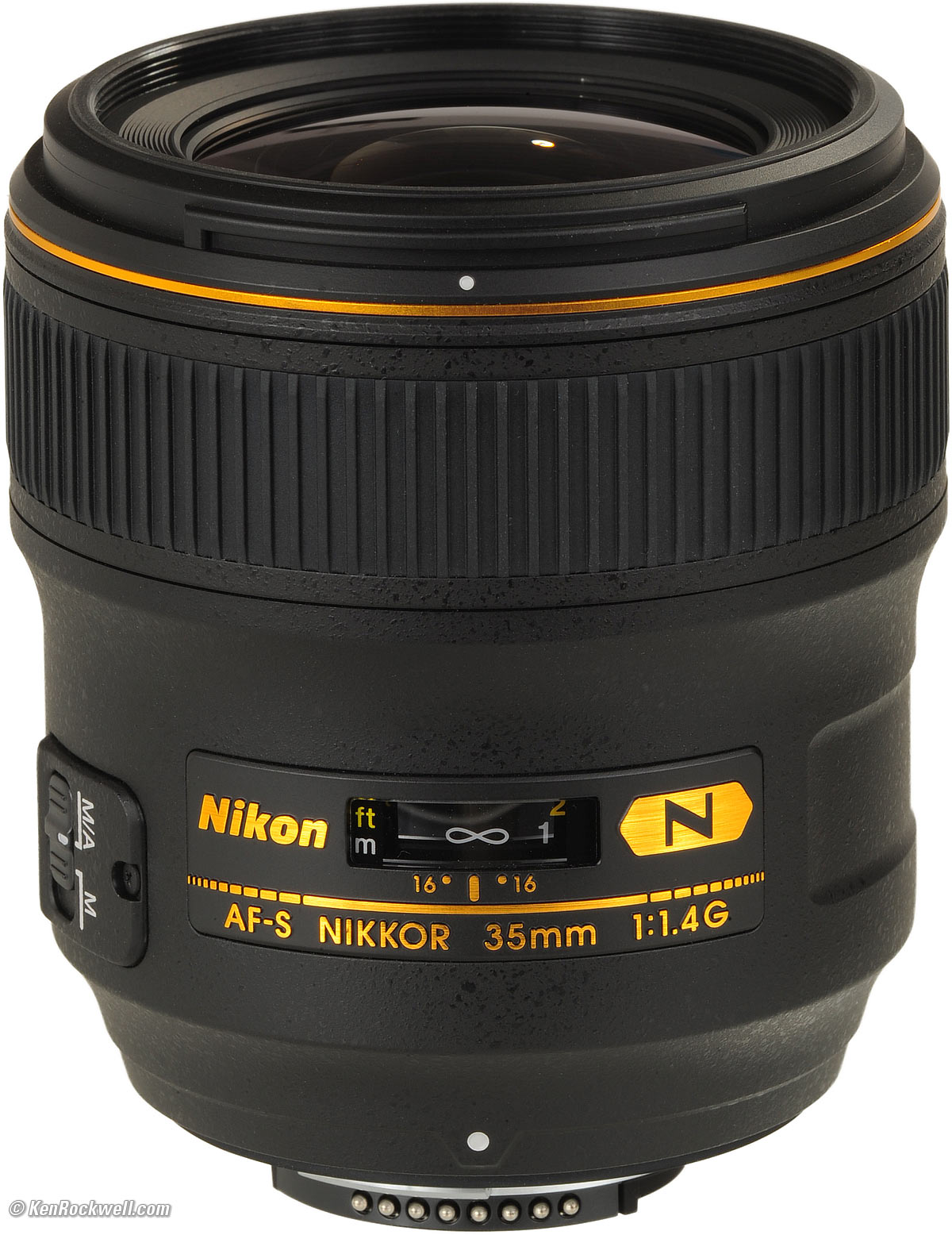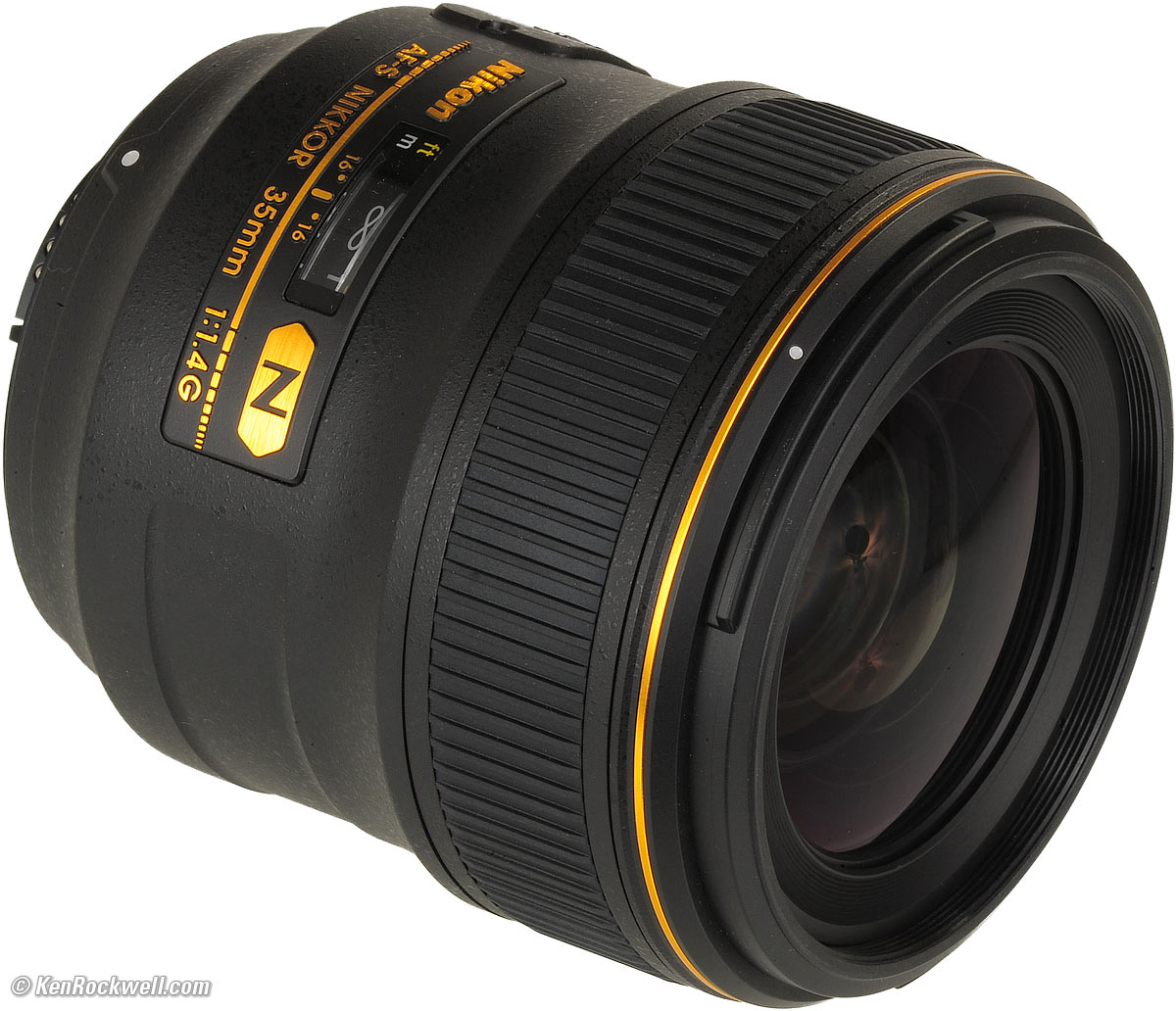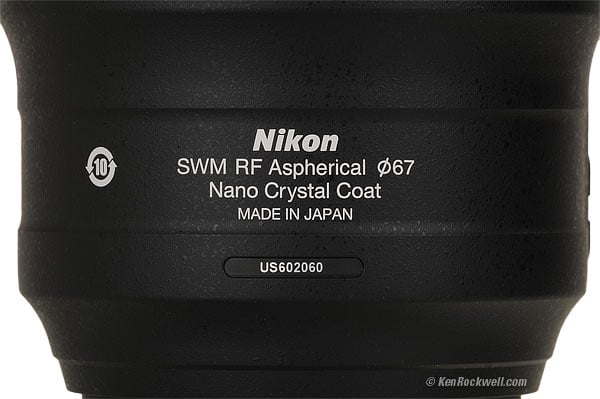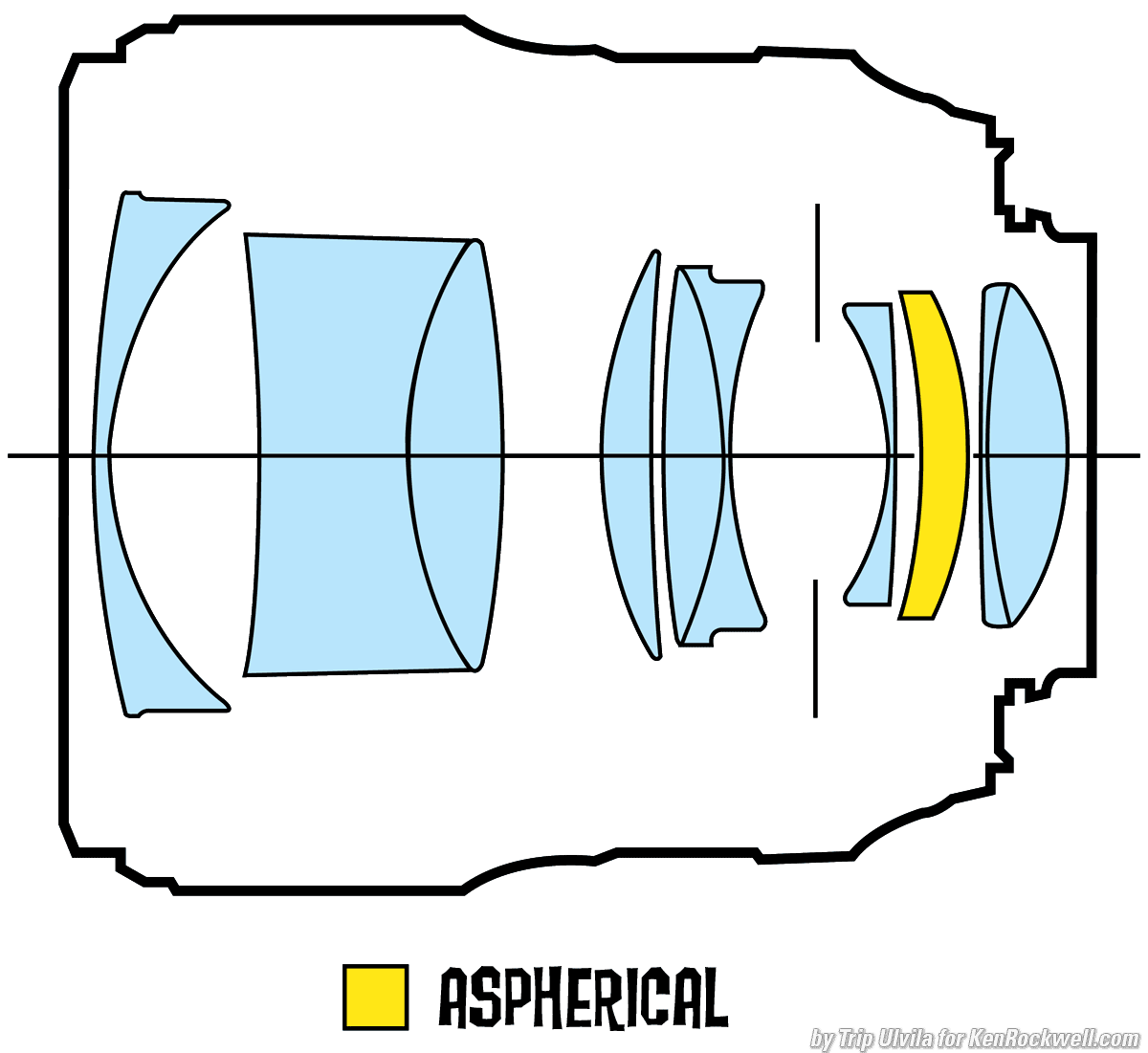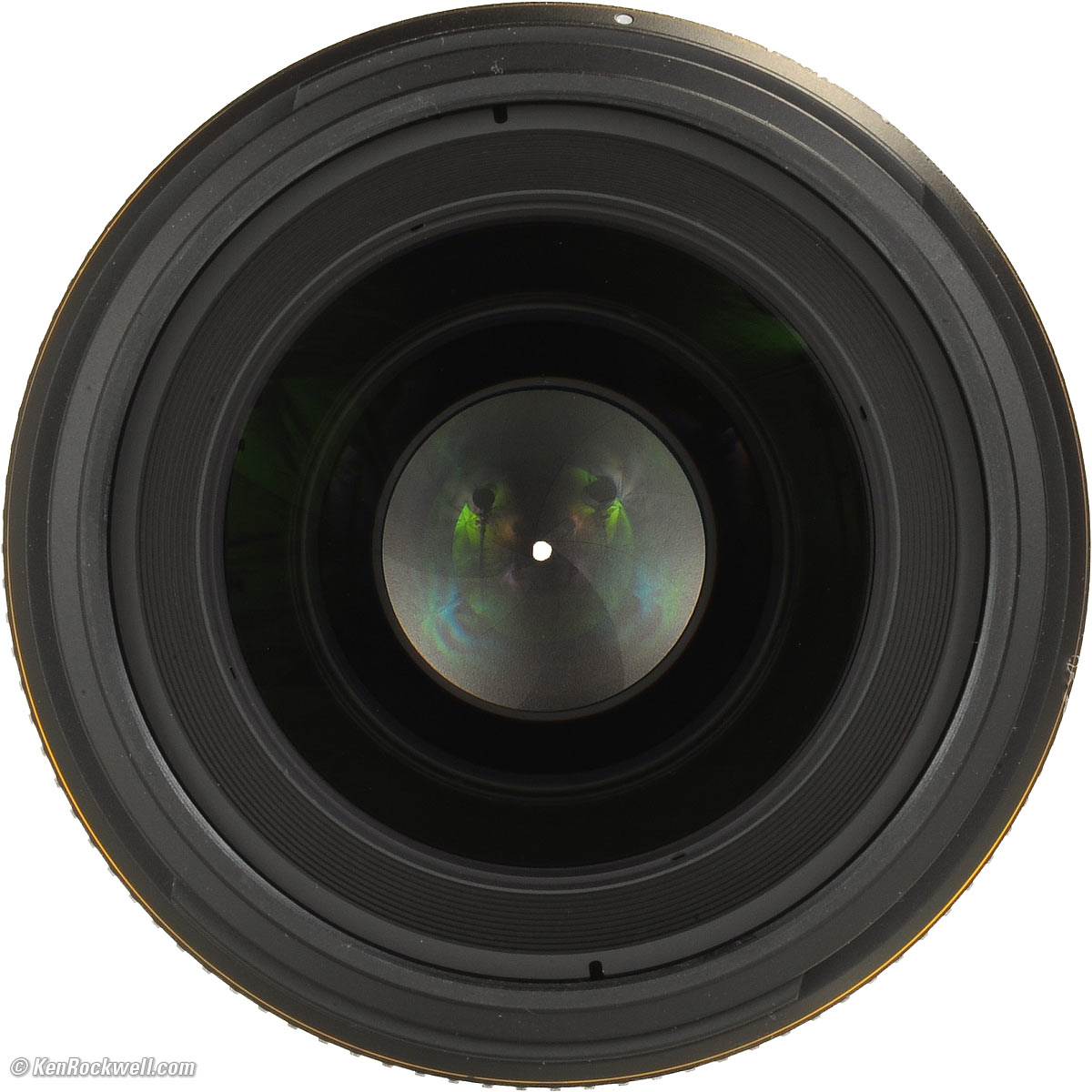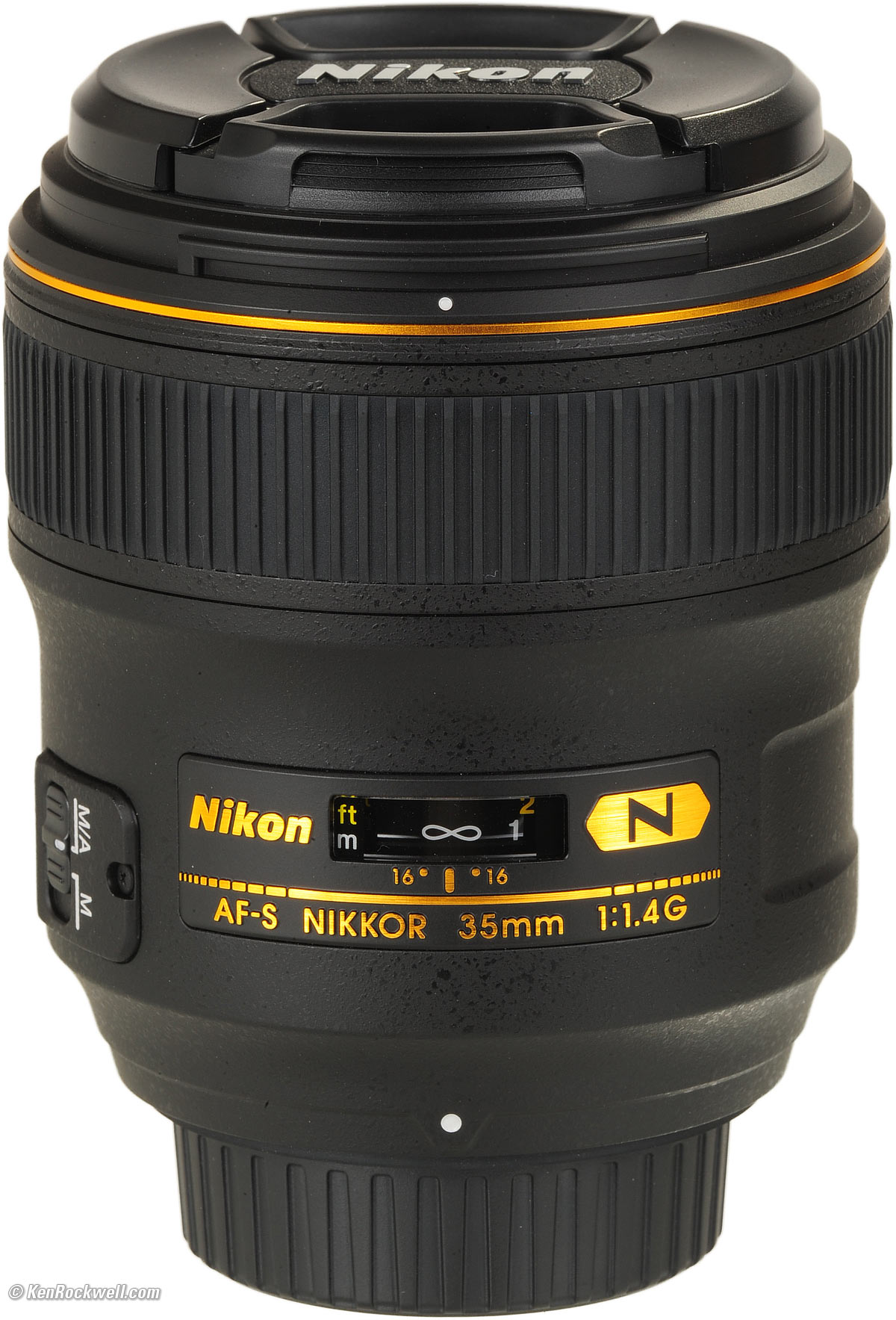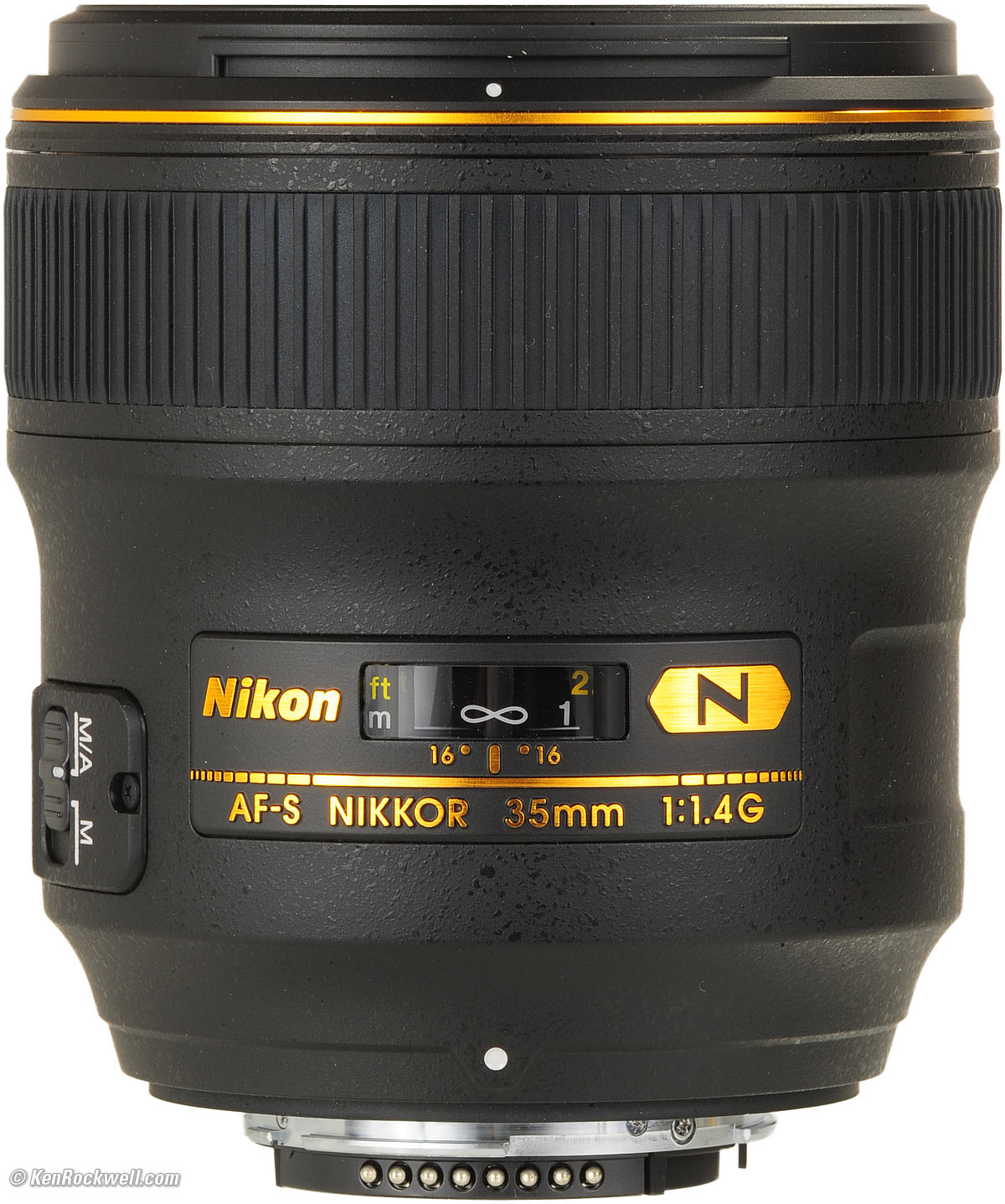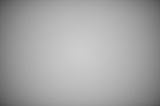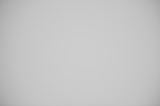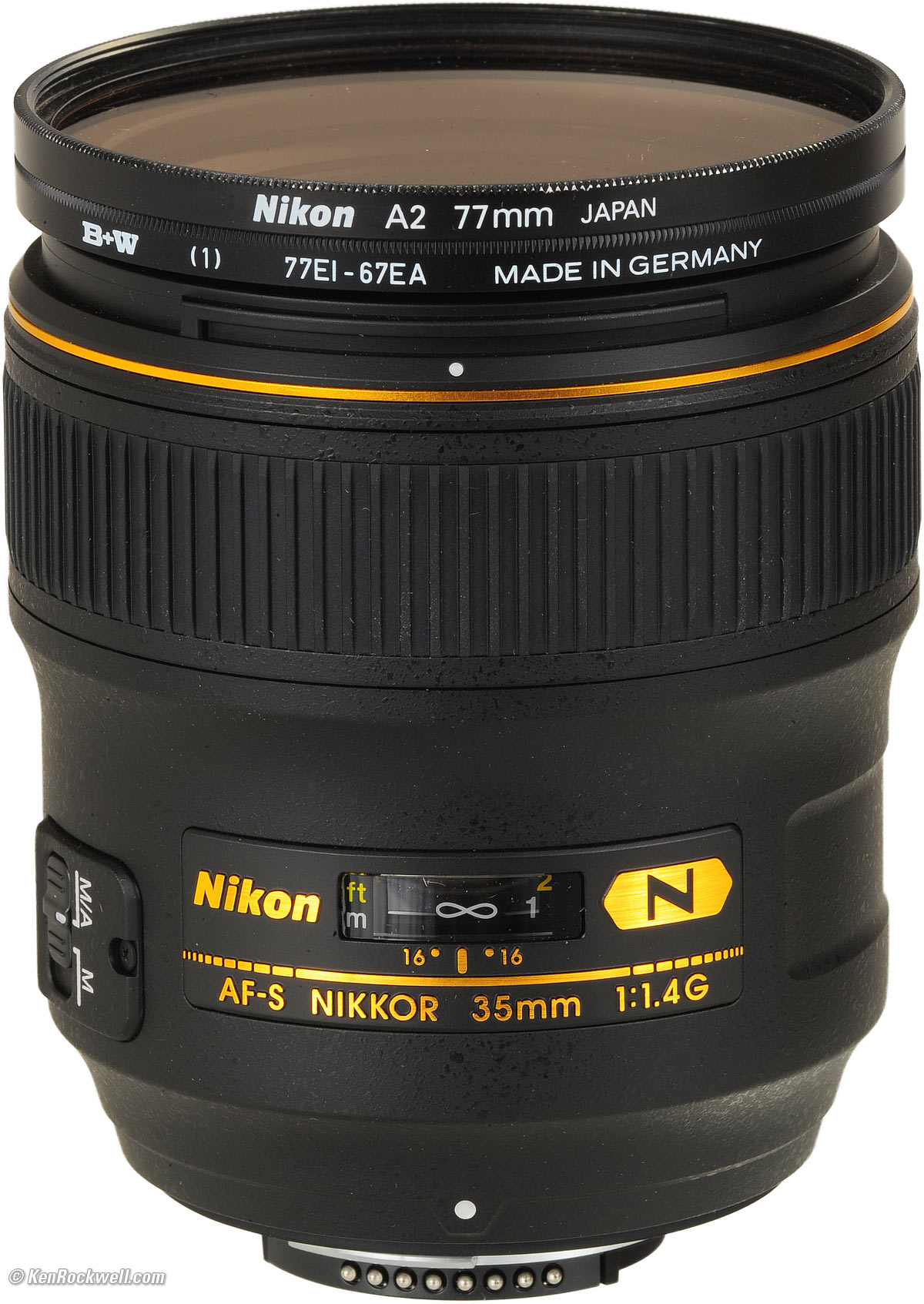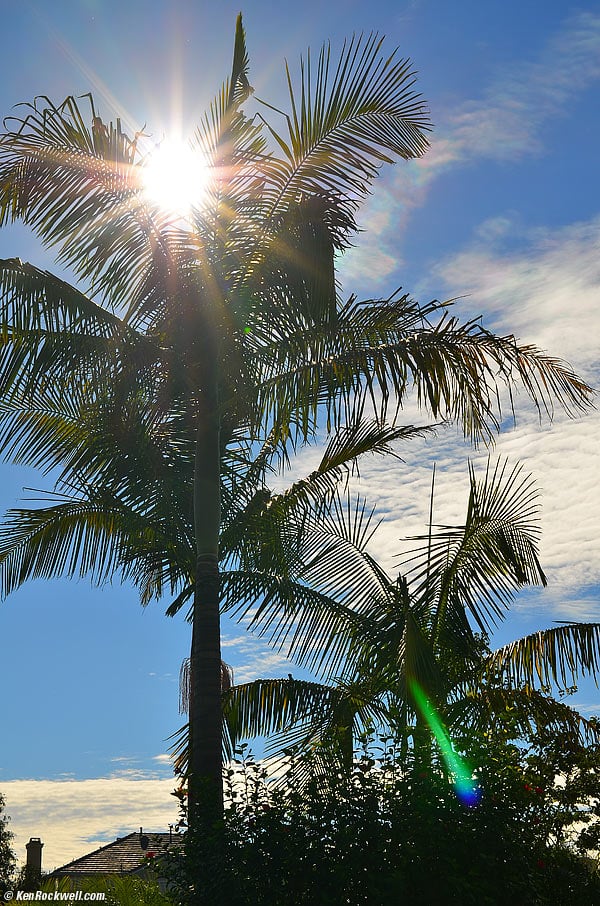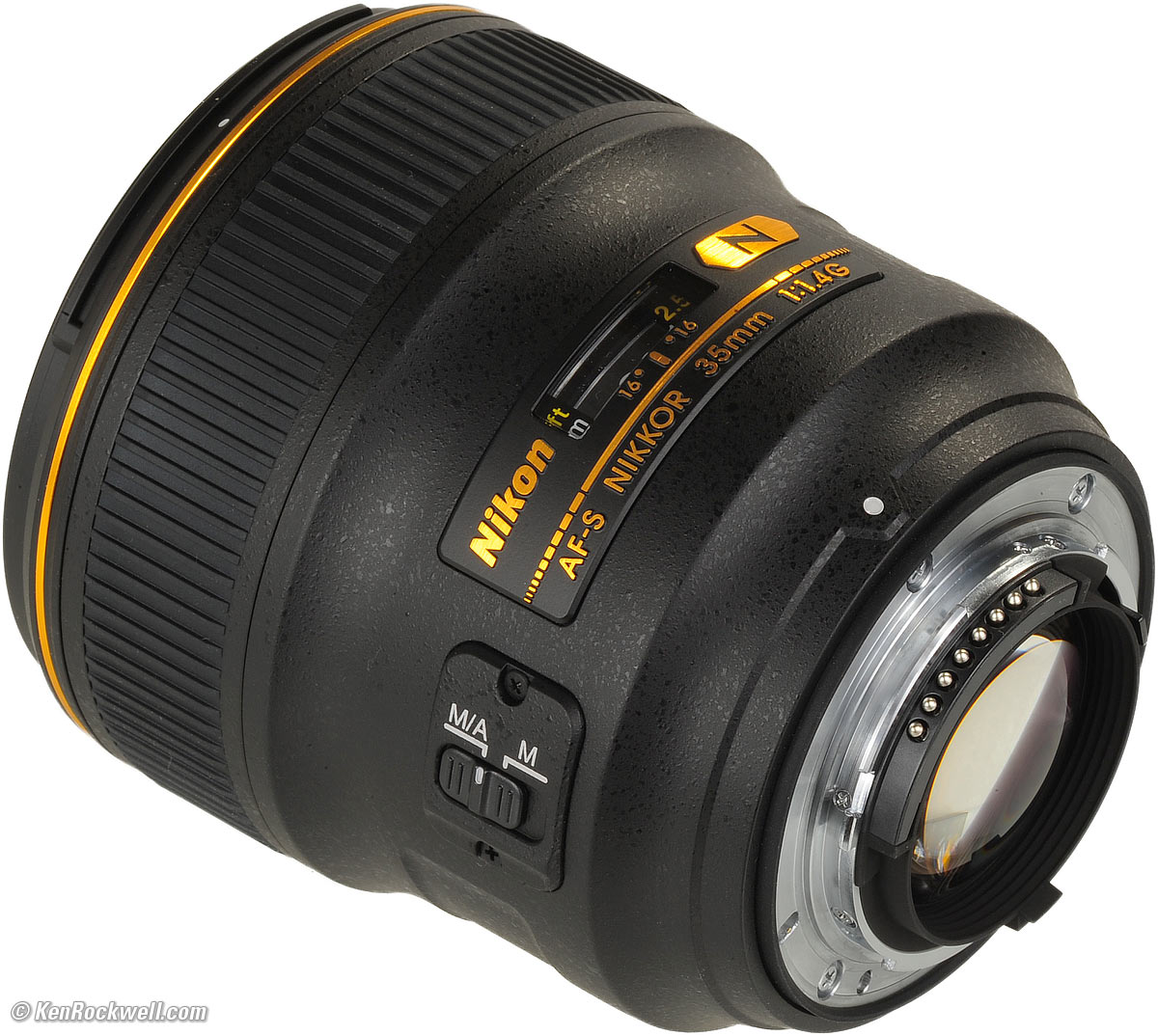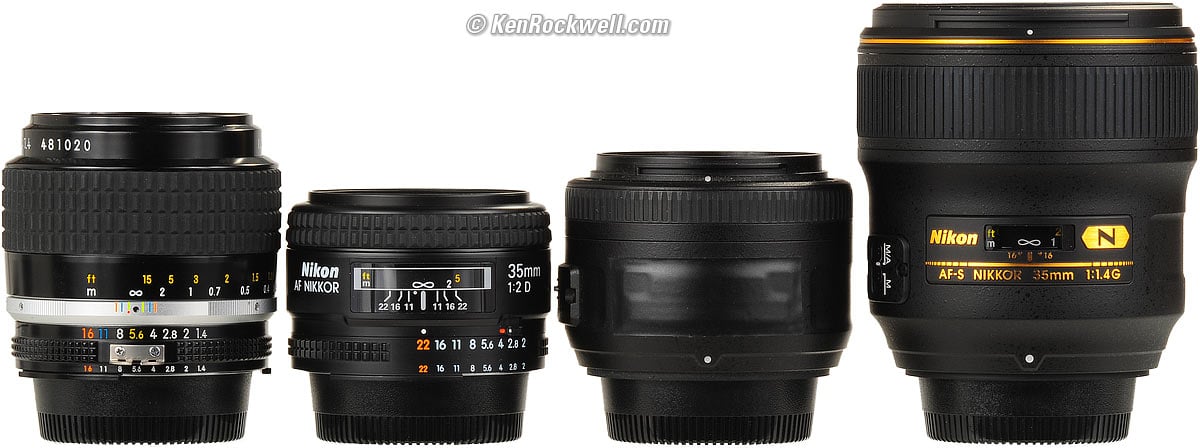Home Donate New Search Gallery Reviews How-To Books Links Workshops About Contact
Nikon 35mm f/1.4 G
AF-S NIKKOR, FX and DX
Intro Specifications Performance Compared Recommendations
Nikon AF-s 35mm f/1.4G (67mm filters, 21.2 oz./600g, 1 foot/0.3m close focus, $1,697 or about $900 used if you know How to Win at eBay). enlarge. I got mine at at Adorama. I'd also get it at Amazon or at B&H, or used at eBay.
This 100% all-content, junk-free website's biggest source of support is when you use those or any of these links to my personally approved sources I've used myself for way over 100 combined years when you get anything, regardless of the country in which you live — but I receive nothing for my efforts if you get it elsewhere. Nikon does not seal its boxes in any way, so never buy at retail or any other source not on my personally approved list since you'll have no way of knowing if you're missing accessories, getting a defective, damaged, returned, dropped, incomplete, gray-market, store demo or used lens — and all of my personally approved sources allow for 100% cash-back returns for at least 30 days if you don't love your new lens. I've used many of these sources since the 1970s because I can try it in my own hands and return it if I don't love it, and because they ship from secure remote warehouses where no one gets to touch your new lens before you do. Buy only from the approved sources I've used myself for decades for the best prices, service, return policies and selection.
| Optics: | |
| Mechanics: | |
| Ergonomics: | |
| Usefulness: | |
| Availability: | |
| Overall: |
December 2021 Nikon Reviews Nikon Lens Reviews Other Reviews
See also
Nikon 35mm f/1.4 AI-s (1970-today)
Nikon 35mm f/1.8 DX (2009-today, about $200)
Samyang 35mm f/1.4 (2011-today)
Ideal for: Perfect for use in low-light as a standard lens. Because of the wider angle compared to 50mm lenses, it can be hand-held at a slower speed, and always has a deeper depth-of-field. The 35mm f/1.4 has been a staple lens of serious professional photographers for decades.
NOT FOR DX. On DX, the 35mm f/1.8 G DX does the same thing for one-tenth the price, with a lot less weight and a better filter size. Neither of these G lenses work on manual-focus film cameras. For them, use the Nikon 35mm f/1.4 AI-s instead. For rich people, this lens works swell on DX, but no better than the 35/1.8 DX does.
Good: Nikon's sharpest 35mm lens ever, but only apparent at large apertures.
Bad: Very expensive, and 99% the same optically as every other 35mm lens or zoom for most purposes at normal apertures.
Introduction top
Intro Specifications Performance Compared Recommendations
|
I buy only from these approved sources. I can't vouch for ads below. |
35mm f/1.4 lenses have been the standard lens of news photographers since Leica's first LEICA 35mm f/1.4 SUMMILUX of 1960 and Nikon's first manual-focus 35mm f/1.4, which is still sold today after forty continuous years of sale!
This brand-new new Nikon 35mm f/1.4 G AF-S NIKKOR is Nikon's first update to their 35mm f/1.4 lens in forty years.
It is even more valuable for 35mm film shooting, since film lacks digital's stupid-high ISOs. With an f/1.4 lens on digital, I can shoot, hand-held, in moonlight.
This new 35mm f/1.4 lacks the heinous coma present in Nikon's first 35mm f/1.4, so that this new lens is much, much better for astronomy, as is the 58mm f/1.2 Noct-NIKKOR.
Nikon tries to impress the innocent with how well subjects can be discriminated at f/1.4 compared to an f/2.8 zoom, but a 50mm lens, even the 50mm f/1.8 AF-D, will do this even better than this 35mm f/1.4.
Nikon hasn't released any new 35mm or FX cameras in a long time, but that's fine, because lenses are far more important. In the past couple of years Nikon has finally redone their core line of 24mm f/1.4 G AF-S (2010, their first ever), 50mm f/1.4 G AF-S, (2008, Nikon invented the world's first 50mm f/1.4 in 1950), 85mm f/1.4 G AF-S (2010, first new version in 15 years), and now this 35mm f/1.4 G AF-S, their first new 35/1.4 in forty years.
I got my AF-S 35mm f/1.4G at Adorama. I'd also get it at Amazon or at B&H, or used at eBay if you know How to Win at eBay.
Nikon 35mm f/1.4 G AF-S. enlarge.
Everything works perfectly on every digital Nikon, both FX and DX, and even on Nikon's cheapest digitals like the D40, D40x, D60, D3000, D3100 and D5000.
It's also perfect on decent or recent AF 35mm cameras like the F6, F100, F5, N80 and N75, as well as on Pronea APS cameras.
The incompatibilities for older or cheaper 35mm cameras are that:
1.) It won't autofocus with the cheapest new AF 35mm cameras like the N55, but if you focus manually, everything else works great. Even if you lose autofocus, these cameras have in-finder focus confirmation dots to help you.
2.) Late 1980s ~ early 1990s AF cameras like the N90s, N70 and F4 will autofocus just fine, but you'll lose Manual and Aperture-priority exposure modes. You'll have Program and Shutter-priority modes, but lose Manual and Aperture-priority since you have no way to set the aperture on the camera or on the lens.
3.) You're really pushing it with the oldest AF cameras like the N2020, N6006 and N8008. You'll have no AF and confused exposure modes. Manual focus is fine, along with electronic focus indications.
4.) Since it has no aperture ring, it's just about useless with manual focus film cameras. It will shoot every shot at its minimum aperture.
See Nikon Lens Compatibility for details with your camera. Read down the "AF-S, AF-I" and "G" columns for this lens. You'll get the least of all the features displayed in all columns, since "G" (gelding) is a handicap which removes features.
Specifications top
Intro Specifications Performance Compared Recommendations
I got my AF-S 35mm f/1.4G at Adorama. I'd also get it at Amazon or at B&H, or used at eBay if you know How to Win at eBay.
Name top
Bottom, Nikon 35/1.4 G.
Nikon calls this the Nikon AF-S NIKKOR 35mm f/1.4 G N.
SWM, AF-S: Silent Wave Autofocus Motor.
RF: Rear focusing.
Aspherical: Specially-curved elements for better pictures.
∅67: 67mm filter thread (E67 in German).
RF: Rear focusing.
Nano: Magic (to the marketing department) anti-reflection coating.
G: Gelded for cost-reduction and removing compatibility with older cameras.
v10^: (10 in rotating arrows): Made of plastic and designed to be thrown away. "10" means about 10 year expected service life before it enters a landfill. (The original 35/1.4 has no such marking, as it is designed to last forever.)
It has no ED glass, and thus uses the gold band around its front without proper authorization. The solid gold band of honor has been reserved only for Nikon's ED lenses.
Optics top
Internal diagram, Nikon 35mm f/1.4. bigger. (graphic by Trip Ulvila.)
10 elements in 7 groups.
One aspherical element.
Rear focusing; nothing moves externally as it autofocuses.
Nikon Super Integrated Coating (SIC), and one surface with nano-crystal coat. Nano-crystal coat is an anti-reflection coating which varies its index of refraction continuously to achieve even greater reflection reduction. It's only on one surface.
See US Patent 7,663,816 for more intricacies.
Diaphragm top
Nikon 35mm f/1.4 G AF-S squinting at minimum aperture. enlarge.
9 rounded blades.
Stops down to f/16.
Coverage top
Focal Length top
36.0mm, as designed.
When used on a DX camera, it gives an angle of view similar to what a 55mm lens gives when used on an FX or 35mm camera.
Angle of View top
63° on FX and 35mm film.
44° on small-format DX.
52º on APS (Pronea).
Close Focus top
1 foot (0.3m).
Maximum Reproduction Ratio top
1:5.
Hard Infinity Focus Stop? top
No.
You have to let the AF system focus at infinity.
Focus Scale top
Yes, but so short that it's not very helpful.
Nikon had a much better focus scale on their 35mm f/2.5 of 1952!
Depth-of-Field Scale top
No, unless you consider the uselessly tiny f/16 marks on a very short focus scale as useful.
If you want a real depth-of-field scale for getting the sharpest pictures, try 1952's 35mm f/2.5.
Infra-Red Focus Index top
No.
Again, 1952's 35mm f/2.5 has a very useful IR index, while this new lens does not.
Aperture Ring top
No.
Filter Thread top
67mm, easy-to-crossthread plastic.
Does not move.
Size top
Nikon specifies 3.3" (83mm) diameter by 3.5" (89.5mm) extension from flange.
Weight top
21.165 ounces (600.0g), measured.
Nikon specifies 21.2 oz. (600g), Bingo!
Hood top
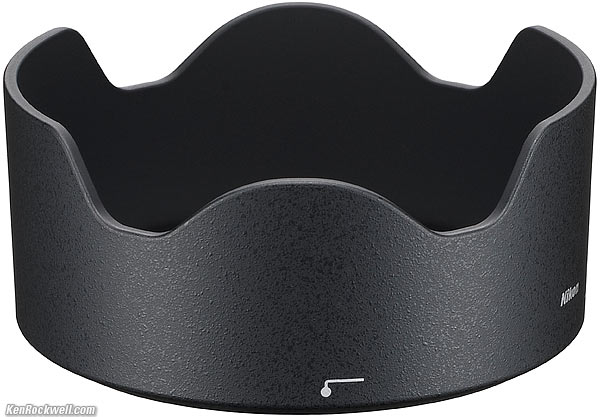
Plastic HB-59 hood.
Plastic bayonet HB-59 hood, included.
Wow! A plastic hood on an $1,800 lens.
Sack top
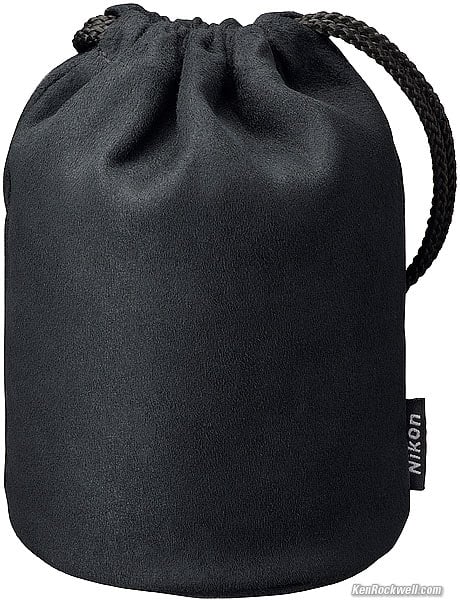
CL-1118 fuzzy sack.
CL-1118 fuzzy, unpadded sack, included, free! Thank you so much, Nikon!
An old used tube sock offers more protection and is easier to use.
Caps top
Capped Nikon 35mm f/1.4 G AF-S. enlarge.
LC-67 67mm snap-on front lens cap.
New-style LF-4 rear cap. This new-style cap costs less to make, and has a fatter flange to keep more dust off the mount while bouncing around in the back of your trunk.
Included top
67mm snap-on LC-67 front lens cap.
LF-4 rear cap.
Plastic bayonet hood HB-59.
Fuzzy cloth pouch CL-1118.
Quality top
Lens: Made in Japan.
LR-4 rear cap: Made in Thailand.
LC-67 front cap: Made in Thailand.
HB-59 hood: Made in Japan. I have to give Nikon credit; I thought for sure this would come from China.
CL-1118 sack made in People's Republic of China, carefully hidden on a black tag inside a black seam at the very bottom of the inside of the sack.
Packaging top
Gold-color printed microcorrugated box.
Lens in simulated "liquid smoke" plastic cage, CL-1118 laid on top of lens carrier in a plastic bag, hood in a plastic bag on top of the sack, thin cardboard stabilizer for hood. Paperwork slid in alongside.
Box, Nikon 35mm f/1.4 G AF-S. enlarge.
Announced top
15 September 2010.
Available top
Shipping since the end of November 2010.
Nikon Product Number top
2198.
Price, USA top
December 2021
$1,697 at Adorama, at Amazon and at B&H,
or
about $900 used if you know How to Win at eBay.
April 2013
December 2012
September 2010
Performance top
Intro Specifications Performance Compared Recommendations
Overall Autofocus Bokeh Cleanliness Color Coma
Distortion Ergonomics Falloff Filters Focus Breathing
Ghosts Lateral Color Fringes Mechanics Sharpness
Spherochromatism Sunstars Survivability
I got my AF-S 35mm f/1.4G at Adorama. I'd also get it at Amazon or at B&H, or used at eBay if you know How to Win at eBay.
Overall performance top
This Nikon 35mm f/1.4 G AF-S is Nikon's sharpest FX 35mm lens, which makes perfect sense, as it's also Nikon's newest and most expensive. You don't need me to tell you this; this new 35/1.4 doesn't disappoint optically.
It disappoints mechanically. Its exterior is all plastic (the mount is metal), which makes it much less pleasant to use than Nikon's first 35mm f/1.4. This new lens' exterior is built only to near-pro standards; I'd be uncomfortable paying $1,800 for this when Nikon's other 35mm f/1.4 is built so much better for a fraction of the price.
Autofocus performance top
AF Speed
AF is fast, but not instantaneous. It takes a moment to lock-on with the precision demanded for accurate focus at f/1.4.
AF Accuracy
AF is generally accurate, which is how I weasel out of saying that it's not as accurate as I'd like to get the best performance at f/1.4.
The problem is that it isn't consistent from shot-to-shot and at different distances if you're more of a pixel-counter than a photographer.
On a 12MP FX D3 it's fine, but I would skip this lens and get the 35mm f/1.8 DX instead for DX cameras like the D7000. On the D7000, if you're shooting critically at f/1.4, the lack of repeatability and varying offsets at different distances eliminate any advantage to this f/1.4 lens over the much smaller and less expensive 35mm f/1.8 DX.
Let me say this again: at each lens' maximum aperture on a D7000, I got better results with the 35mm f/1.8 DX than with this $1,800 lens, and, duh, performance at maximum aperture is the ONLY reason to buy this lens over the f/1.8 for DX.
For FX, this is a fantastic lens, but for DX, it doesn't cut it.
Manual Focus
Manual focus is fine. The manual-focus ring is a little smoother than other AF-S lenses.
M/A - M Switch
Nikon goofed. This switch is supposed to be labeled "A - M."
The "M/A" position means autofocus. It's called "M/A" because you also can focus manually simply by grabbing the focus ring in this position.
The "M/A" position means autofocus. It's called "M/A" because back in the old days, when Nikon had almost caught up to Canon who had been doing this for ten years before, Nikon was trying to show off that you could focus manually while in the AF position.
Paint over the extra M if you're easily confused.
Bokeh performance top
Bokeh, the character of out of focus backgrounds, not simply how far out of focus they are, is great at f/1.4 and f/2, and becomes neutral from about f/2.8. It's the same in the center or at the sides.
Don't let Nikon snow you: if you need to make backgrounds go away, no 35mm lens does this well; get a longer lens. Even the 50mm f/1.8D does a better job defocusing backgrounds. Defocus is much more dependant on focal length than on f/number.
Here are crops from the center of 100% FX 12MP (D3 or D700) images, focused on a reference phase lattice at 3 meters (10 feet) with synthetic reference vegetation at 15 meters (50 feet). Printed full-image at this size, these would be about 42 x 28" (105 x 70cm) prints, at least as seen on most 100 DPI computer monitors:
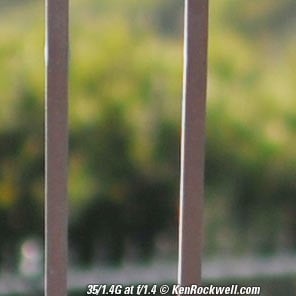 |
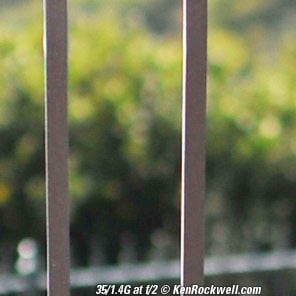 |
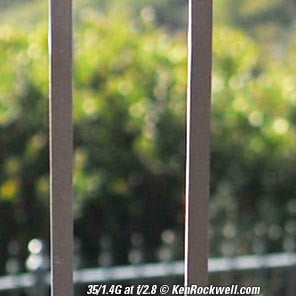 |
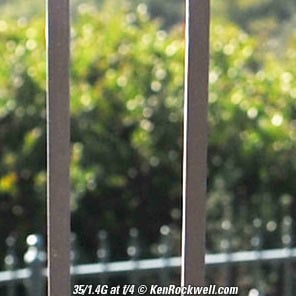 |
The 35 1.4's spherochromatism usually helps bokeh outdoors, since it smooths and adds green fringes to out-of-focus backgrounds.
Cleanliness (Switzerland only) performance top
My sample arrived with some microscopic specs of white dust on the exterior.
Not that anyone would notice outside of Japan or Switzerland, but since it took me 10 minutes to spot-out this dust for my product shots, I figured I'd tell you about it. I shoot in a class 10,000 clean room and wear a bunny suit and gloves, so I see these things.
Color Rendition performance top
The color rendition of this 35/1.4 matches my other NIKKORs, as expected.
Coma performance top
The coma performance of this new Nikon lens is spectacular.
This aspherical 35/1.4 has almost no coma, far better than the original Nikon 35mm f/1.4 AI-s or LEICA SUMMILUX 35mm f/1.4.
Coma (saggital coma flare) often causes weird smeared blobs to appear around bright points of light in the corners of fast or wide lenses at large apertures. In lenses that have it, coma goes away as stopped down.
Here is an overview of the entire 12MP FX D3 frame. It was a hazy evening:
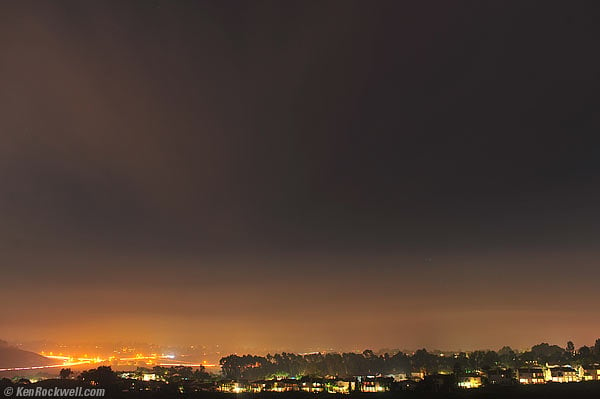
Guide Image.
Here are crops from 100% images from the far lowest left corner:
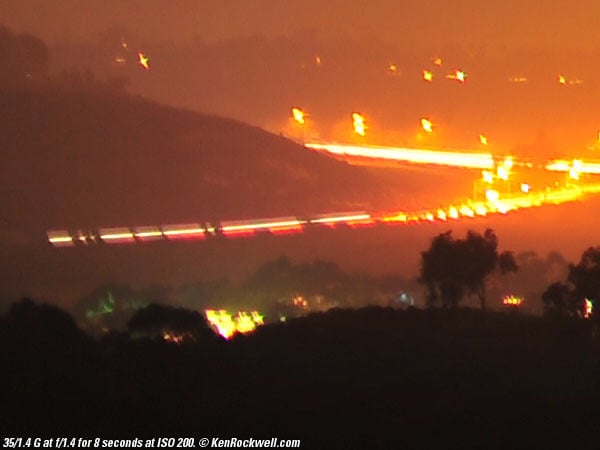
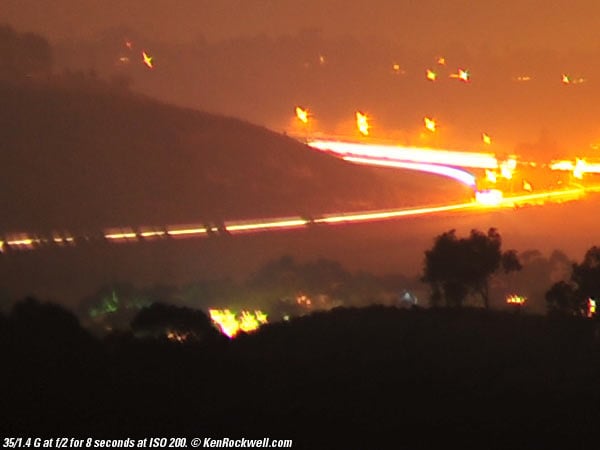
f/2 looks the same as f/1.4 in the corner because, due to mechanical vignetting, f/1.4 is the same as f/2 in the corners! This lens, like all f/1.4 lenses, is only f/1.4 in the very center.
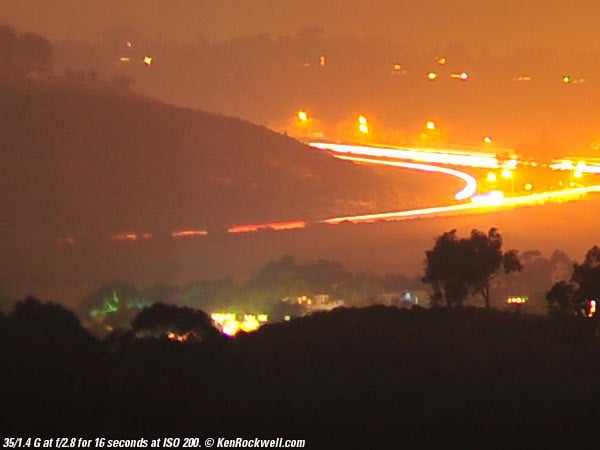
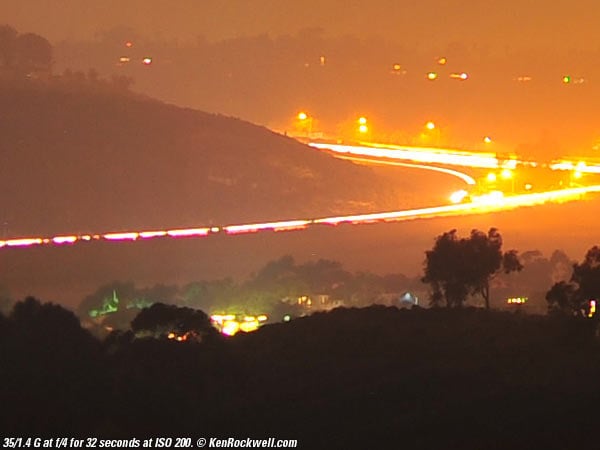
For comparison, here is the original 35/1.4 AI-s at the same time under the same conditions:
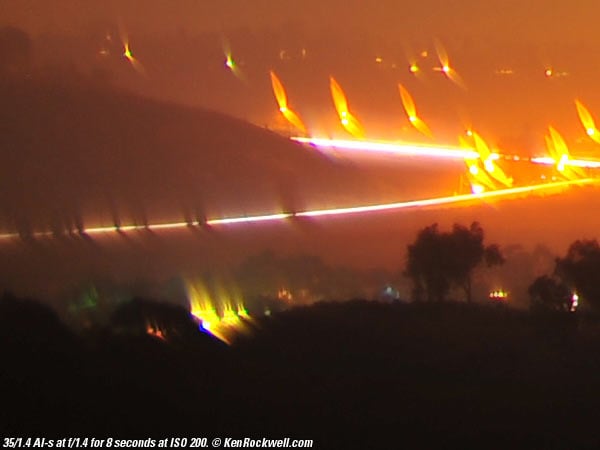
Distortion performance top
The Nikon 35 1.4 G has the same barrel distortion as Nikon's original 1960 35mm f/1.4. I am not impressed. Nikon has made NO progress in 40 years, and this lens' distortion is slightly complex and more difficult to correct than the distortion from Nikon's better-made original 35/1.4.
This can be corrected for critical use by plugging these figures into Photoshop's lens distortion filter. These aren't facts or specifications, they are the results of my research that requires hours of photography and calculations on the resulting data.
FX and Film |
||
at 10' (3m) |
+1.5* |
+1.2 |
© 2010 KenRockwell.com. All rights reserved.
* some waviness remains.
See Nikon's Patent for distortion curves.
Ergonomics performance top
Nikon 35mm f/1.4 G AF-S. enlarge.
Ergonomics are swell. Hold the lens, shoot.
Want manual focus? Just grab the focus ring at any time.
To lock-out auto focus, move the switch which is right under your thumb.
Falloff (darkened corners) performance top
Falloff on FX is the same as the original 35mm f/1.4 AI-s. Both have strong falloff at f/1.4 which improves greatly at f/2, and is gone by f/2.8.
It won't be an issue on DX (see crop factor).
I am not impressed: Nikon has made no progress here, and to my jaundiced eye, this new lens might be a little worse than the much smaller, less expensive and better-made original 35mm f/1.4 AI-s.
I've exaggerated this by shooting a gray field and placing these on a gray background.
Nikon 35mm f/1.4 G AF-S falloff on FX and film at infinity, no correction.
© 2010 KenRockwell.com. All rights reserved.
|
Filters, use with performance top
There is no problem with vignetting, even with combinations of thick filters. 67mm is a generously large filter size.
The filter ring never moves.
Be sure to order a B+W 67 -> 77mm step-up ring with your 35mm f/1.4, and install it the moment you open the box. This lets us treat this lens forever as a 77mm filter-thread lens to match all our other pro Nikon lenses, and also gives us a solid-brass filter thread.
Nikon did us a favor with the screwy 67mm filter size, which is standard only if you're also shooting this alongside a Mamiya 6 or Mamiya 7 system, because it's easy to use this metal step-up ring to get us back to the standard 77mm size, and give us even more leeway to shoot with stacked filters.
This B+W adapter ring says MADE IN GERMANY, so you can impress your snobby LEICAFRIENDS, especially if they are slumming with Canadian lenses or cameras.
Nikon 35mm f/1.4 G AF-S with 77mm filter thread. enlarge.
I'd leave either a 77mm Nikon Clear (NC - UV) filter, or a 77mm Hoya Super HMC UV on the lens at all times. I would leave the hood at home.
If I was working in nasty, dirty areas, I'd forget the cap, and use an uncoated 77mm Tiffen UV filter instead. Uncoated filters are much easier to clean, but more prone to ghosting.
For color slides like Velvia 50 outdoors, I use a 77mm Hoya HMC 81A, or the Nikon A2 filter as shown here.
For B&W film outdoors, I'd use a 77mm Hoya HMC Yellow K2 or 77mm Hoya HMC Orange.
Focus Breathing performance top
Of interest mostly to cinematographers focusing back and forth between two subjects, the image from the Nikon 35mm f/1.4 G AF-S gets slightly larger as focused more closely.
Ghosts performance top
Even with the marketing department's use of the "N" word for nano coating, ghost performance is the same as the other Nikon 35mm lenses compared here.
Point it into the sun, and you'll usually get an emerald dagger thusly:
Snapped on a DX D7000 at f/11.
Lateral Color Fringes performance top
There are no lateral color fringes on the D3 or D7000, which corrects them automatically.
Mechanics and Construction performance top
Nikon 35mm f/1.4 G AF-S. enlarge.
For an $1,800 lens, I'm disappointed. I sent mine back because it's all plastic.
I'll be dipped if I'm going to part with three times as much as I paid for my first car to buy a lens with a plastic filter thread, plastic focus ring and a glued-on serial number.
I'm whining; if you're a pro for whom this lens is intended, you'll love it. I already own the somewhat superior (and even more expensive) 24mm f/1.4 G AF-S, so I'm set personally.
Filter Threads
Plastic.
Hood
Plastic bayonet.
Hood Mount
Plastic.
Barrel Exterior
Plastic.
Focus Ring
Plastic; rubber covered.
Nikon's similar 24mm f/1.4 G and 85mm f/1.4 G lenses have metal focus rings, but not this lens.
Depth-of-Field Scale
None: just two useless little tits for f/16.
Internals
Metal, I hope.
Aperture Ring
None.
Mount
Dull-chromed brass.
Markings
Paint.
Identity Plate
Debossed metal.
Serial Number
Printed on a sticker glued on the bottom rear of barrel, near mount.
US Model Signified by
"US" prefix to serial number.
Ass-Gasket (rain seal at mount)
Yes.
Noises When Shaken
Muffled clunking.
Made in
Japan.
Weaknesses
I'd be very careful not to cross-thread the plastic filter thread.
Sharpness performance top
Warning 1: Image sharpness depends more on you than your lens.
Warning 2: Lens sharpness doesn't mean much to good photographers.
With these caveats, this is Nikon's sharpest 35mm lens ever.
This new 35/1.4 is much better than Nikon's original 35/1.4 and Leica's Canadian 35/1.4 at large apertures. Unlike the originals, this new lens is sharp and contrasty even at f/1.4. (Leica is already on their fourth-generation 35/1.4; this is merely Nikon's second.)
On a 12MP FX D3
It's sharp and contrasty everywhere at every setting.
It's just a tiny bit softer at f/1.4 in the far corners, but only by direct comparison to a stop or two down, and then only visible under special test conditions at infinity. Compared to any other Nikon FX 35mm lens, it's way better.
These differences are only visible at large apertures. At small apertures, all lenses look equally sharp.
On a 16MP DX D7000
It's sharp and contrasty everywhere at every setting.
It's just a little less contrasty at f/1.4, but you'd only notice this by direct comparison to the other apertures with the same subject.
Nikon's claimed MTF curves:
Nikon 35mm f/1.4 G AF-S claimed MTF at f/1.4.
Spherochromatism performance top
Spherochromatism, sometimes mistakenly called "color bokeh" by laymen, is a minor aberration which can add slight color fringes to out-of focus highlights.
The 35/1.4 G has a lot of spherochromatism, albeit usually invisible.
You will see green tinges on out-of-focus background highlights, and magenta fringes on out-of-focus foreground highlights.
Here's a complete DX image:
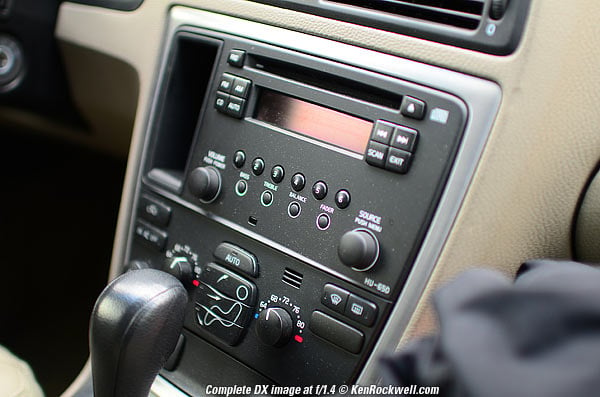
At f/1.4 on DX, focus on "BALANCE."
And here's a tight crop from this image at 100%:
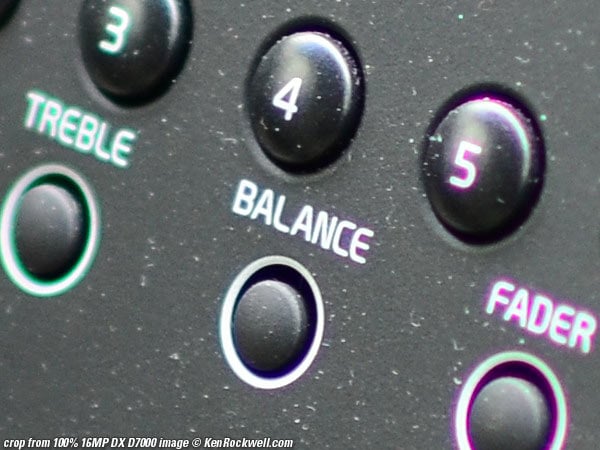
Sunstars performance top
With its partially curved 9-bladed diaphragm, the Nikon 35 1.4 G makes softer 18-pointed sunstars on bright points of light than more traditional lenses.
Here's what you'll get at f/11 on DX:
Survivability performance top
The Nikon 35mm f/1.4 G AF-S has a plastic outer barrel, which can take quite a beating.
I banged this lens in a car door, and it didn't even show it.
My concern is wear to the plastic filter thread with continued use by serious photographers, and that Nikon's AF-S motors do fail.
If in 30 years from today the AF-S motor is irreparable, you've dead, while the original 35mm f/1.4 AI-s will still be shooting.
Compared performance top
Intro Specifications Performance Compared Recommendations
Nikon 35mm f/1.4 AI-s, 35mm f/2 D, 35mm f/1.8 DX and 35/1.4 G. enlarge.
Current Nikon 35mm Lenses (same order as photo above)
35/1.4 G |
|||||
| Introduced | 1970 |
1989 |
2009 |
2010 |
2010 |
| Actual focal length | 36.0mm |
36.0mm |
24.0mm |
||
| Filter | 52mm |
52mm |
52mm |
67mm |
77mm |
| Filter | Metal |
plastic |
plastic |
plastic |
plastic |
| Barrel | Metal |
plastic |
plastic |
plastic |
plastic |
| Mount | Metal |
Metal |
Metal |
Metal |
Metal |
| OK on manual-focus cameras? | Yes |
Yes |
Yes |
no |
no |
| OK on DSLRs? | Yes |
Yes |
Yes |
Yes |
Yes |
| Optics | 9/7 CRC |
6/5 |
8/6 |
10/9 ASPH |
12/10 ASPH |
| Diaphragm Blades | 9 |
7 |
7 rounded |
9 |
9 |
| f/minimum | 16 |
22 |
22 |
16 |
16 |
| Focus | Manual |
AF-D |
AF-S |
AF-S |
AF-S |
| Instant manual-focus override? | Yes |
no |
Yes |
Yes |
Yes |
| Focus Scale | Yes |
Yes |
no |
Yes |
Yes |
| Depth-of-field scale | Yes |
Yes |
no |
not really |
Almost |
| Infra-red index | Yes |
Yes |
no |
no |
no |
| Close Focus | 0.3m |
0.25m |
0.3m |
0.3m |
0.25m |
| Maximum Repro Ratio | 1:5.5 |
1:4.2 |
1:6.1 |
1:5 |
1:5.6 |
| Weight | 381g |
200g |
197g |
600g |
618g |
| Price, 12/2010 | |||||
| Price, 4/2013 | |||||
| Price, 12/2021 |
Sharpness
At large apertures, and in the corners where sharpness differences are most visible, this 35mm f/1.4 AF-S G is easily superior. It's sharp and contrasty, even at f/1.4 in the FX corners, while the 35/2 D isn't as good, and the 35/1.4 AI-s is downright blurry.
In the center, the AI-s is a bit less contrasty at f/1.4, otherwise, the 35/2D, 35/1.8 DX, 35/1.4 AI-s and this 35/1.4 G are the same.
Stopped down to f/8 where we shoot most of the time, all these lenses are as sharp as one another.
Ghosts
Here's the same thing, shot manually at 1/250 at ISO 200 on an FX D3:
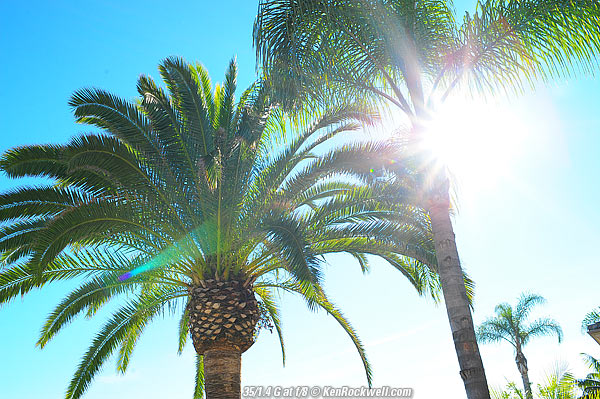
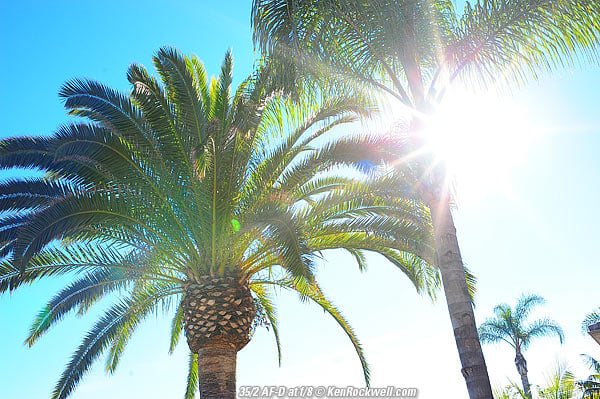
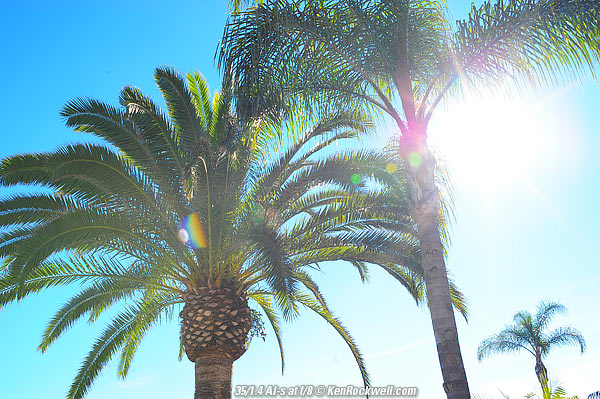
These look the same to me. Move each lens a little and the ghosts will move around.
Regardless of how wonderful Nikon's Nano coating may be, it's used only on one surface of the 35mm f/1.4 G, mostly for marketing purposes. The 35/1.4 G has the most pieces of glass in it to cause more reflections in the first place.
The 35/2 AF-D has the fewest ghosts.
To the 35/1.4 G's credit, it has the least flare; look at the dark park of the palm.
Recommendations top
Intro Specifications Performance Compared Recommendations
I got my AF-S 35mm f/1.4G at Adorama. I'd also get it at Amazon or at B&H, or used at eBay if you know How to Win at eBay.
Buy this lens only for 35mm film or FX.
This 35mm f/1.4 G AF-S is a very expensive professional FX and 35mm film lens. It costs ten times as much as the 35mm f/1.8 DX, which does exactly the same thing on DX.
This lens costs so much more because it is limited production, has to cover a much larger format, and is almost a stop faster. It's not any sharper than the 35/1.8 DX, but these other factors multiply to make this lens ten times as expensive as the DX 35mm, and three times as heavy.
This lens is for shooting film in low-light, and for shooting action in low-light on digital. It lets you shoot at ISOs of one-quarter what you'd need at f/2.8, or one-eighth of what you'd need with the 16-35mm VR.
Pros have been expecting this lens for a long time, as Nikon's only 35mm f/1.4 lens since 1970 has been the manual focus 35/1.4 AI-s.
This 35mm f/1.4 G, along with Nikon's new 24mm f/1.4 G, 50mm f/1.4 G AF-S and 85mm f/1.4 G AF-S, are extremely welcome additions for professional photographers who don't shoot no stinking 28-300mm zooms.
For most people shooting digital of still subjects in anything brighter than moonlight, or with a tripod, these f/1.4 lenses aren't needed. You get more in-focus stopped-down, but for photographing people or anything that moves in dim light, f/1.4 lenses have always been needed.
If you get this 35mm f/1.4, you don't need to carry the 24mm f/1.4 G and 50mm f/1.4 G AF-S at the same time, because they are so close in focal length. Bring only this 35/1.4 and the 85mm f/1.4 G AF-S. If you bring the 24mm f/1.4 G and 50mm f/1.4, leave the 35mm f/1.4 back at the studio. It's always a good idea to own all this, but an even better idea to carry as little as possible when you go out.
When you bring this 35mm lens, don't carry any zoom that also covers 35mm, which would be redundant. See Assembling a System.
This is Nikon's sharpest 35mm lens, but only under special conditions. 99% of the time, the results are indistinguishable from any other lens or zoom. This lens is expensive because it is designed to work well at large apertures and cover FX, but if you don't need f/1.4 and FX coverage, the cost remains, but the advantage disappears.Pros who need this know who they are. If you have to ask yourself if it's worth $1,700, it isn't. See also Is It Worth It.
I got my AF-S 35mm f/1.4G at Adorama. I'd also get it at Amazon or at B&H, or used at eBay if you know How to Win at eBay.
This 100% all-content, junk-free website's biggest source of support is when you use those or any of these links to my personally approved sources I've used myself for way over 100 combined years when you get anything, regardless of the country in which you live — but I receive nothing for my efforts if you get it elsewhere. Nikon does not seal its boxes in any way, so never buy at retail or any other source not on my personally approved list since you'll have no way of knowing if you're missing accessories, getting a defective, damaged, returned, dropped, incomplete, gray-market, store demo or used lens — and all of my personally approved sources allow for 100% cash-back returns for at least 30 days if you don't love your new lens. I've used many of these sources since the 1970s because I can try it in my own hands and return it if I don't love it, and because they ship from secure remote warehouses where no one gets to touch your new lens before you do. Buy only from the approved sources I've used myself for decades for the best prices, service, return policies and selection.
More Information top
US Patent 7,663,816, by the fruitful Haruo Sato, Kawaguchi.
Nikon's Full-Line Lens Brochure
Help me help you top
I support my growing family through this website, as crazy as it might seem.
The biggest help is when you use any of these links to Adorama, Amazon, eBay, B&H, Ritz, Calumet, J&R and ScanCafe when you get anything, regardless of the country in which you live. It costs you nothing, and is this site's, and thus my family's, biggest source of support. These places have the best prices and service, which is why I've used them since before this website existed. I recommend them all personally.
If you find this page as helpful as a book you might have had to buy or a workshop you may have had to take, feel free to help me continue helping everyone.
If you've gotten your gear through one of my links or helped otherwise, you're family. It's great people like you who allow me to keep adding to this site full-time. Thanks!
If you haven't helped yet, please do, and consider helping me with a gift of $5.00.
As this page is copyrighted and formally registered, it is unlawful to make copies, especially in the form of printouts for personal use. If you wish to make a printout for personal use, you are granted one-time permission only if you PayPal me $5.00 per printout or part thereof. Thank you!
Thanks for reading!
Mr. & Mrs. Ken Rockwell, Ryan and Katie.
Home Donate New Search Gallery Reviews How-To Books Links Workshops About Contact
